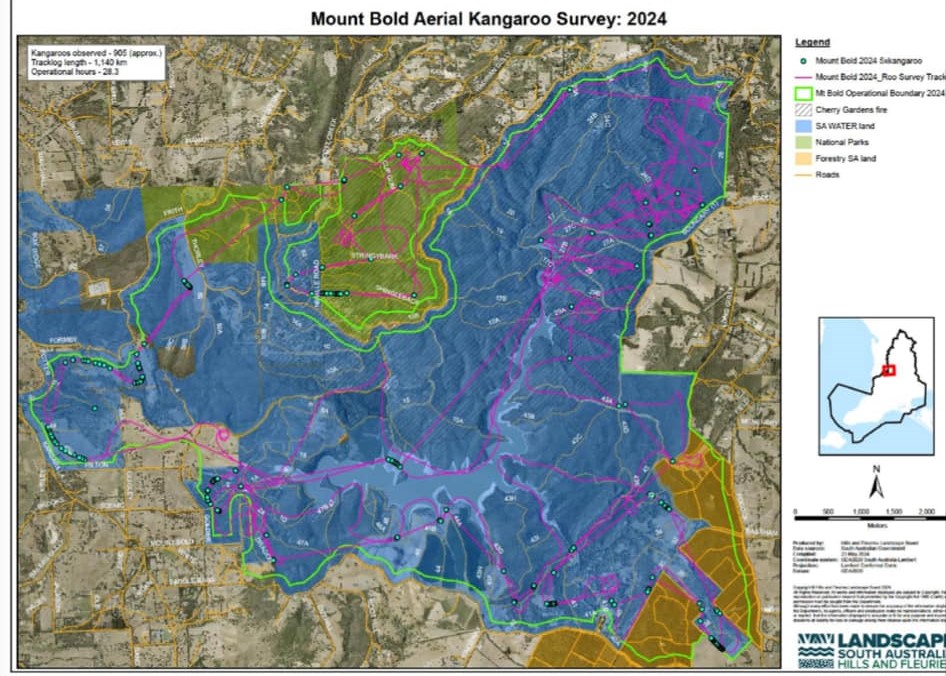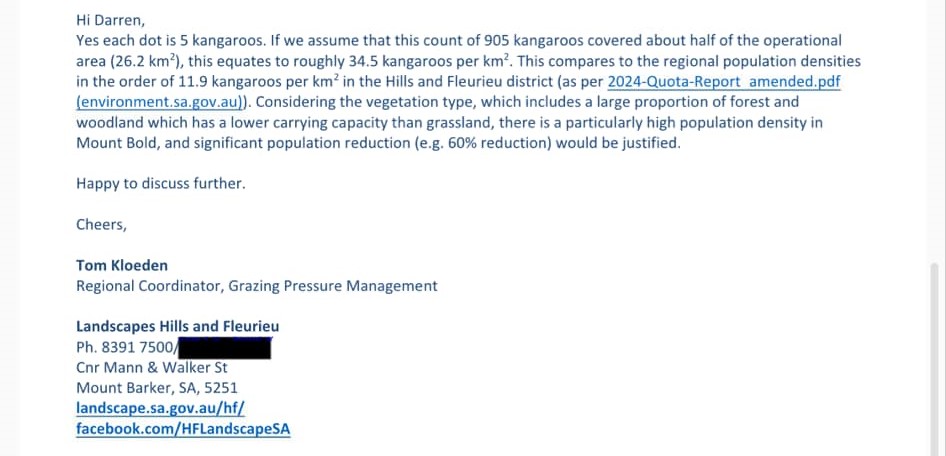In October 2024, the President of the SA Kangaroo Alliance obtained details of a survey conducted at Mt Bold Reservoir to survey kangaroo numbers. The information received was disturbing.
BACKGROUND
Landscape South Australia is the name given to the system for managing South Australia’s landscapes.
Eight regional landscape boards and Green Adelaide work with partners to deliver practical, on-ground programs to manage landscapes. They invest landscape levies into regional priority issues as well as leveraging Australian Government funding towards managing and protecting our productive and natural landscapes.
The Landscape Priorities Fund is funded from landscape levies collected by Green Adelaide in the Adelaide metropolitan area and redistributed to South Australia’s regional landscape boards to enable them to work in partnership with other groups and individuals and invest in environmental projects.
The Kangaroo Partnership Project aims to assist in managing the significant threat to the environment posed by populations of kangaroos, and ultimately improve the landscape and economic resilience of communities in regional South Australia.
Funded by the Landscape Priorities Fund, the program gathers key stakeholders together to explore and trial shared solutions. SA Water was one of the organisations committed to the Kangaroo Partnership Project.
Roles of the Kangaroo Partnership Project include:
* Explore barriers and opportunities to support kangaroo field processor industry growth and development;
* Work collaboratively to support product demand i.e. education, marketing and awareness raising; and
* Work with regulators to inform harvest issues and opportunities for improvement.
The Kangaroo Partnership Project appointed a coordinator whose duty was to maximize harvesting and management outcomes so both economic and environmental outcomes could be more fully realised.
KANGAROO SURVEY OF MT BOLD RESERVOIR

Landscape South Australia Hills and Fleurieu conducted an aerial survey of the Mt Bold Reservoir in 2024. Apparently, 905 kangaroos were seen from the air in 25.3 hours in 26.2 square kilometres. The dots on the map above indicate 5 kangaroos were seen by observers. This method of conducting a population survey doesn’t make sense. You wouldn’t just count groups of 5 kangaroos and ignore a lone kangaroo or smaller groups of 2, 3 or 4 kangaroos. In normal circumstances, a dot on a survey map would indicate one animal. If there is a cluster of dots, the cluster indicates more than one animal. It would be odd to only count groups of 5 kangaroos and ignore all other combinations.
However, one of the problems with kangaroo surveys conducted by government departments is the arbitrary use of correction factors. If one Western Grey Kangaroo is seen by an observer during an aerial survey, the assumption is made that the observer missed the other 80% of kangaroos present on the ground but apparently invisible to the observer. There is no evidence that the other 80% of kangaroos were actually there. No one saw them. Nevertheless, the assumption is made that one kangaroo seen means that 4.956629492 kangaroos were actually there but the observer missed the other 3.956629492 kangaroos. I know this method doesn’t make sense but this method is currently used by SA government departments. Therefore, each dot most likely represents one kangaroo actually seen by an observer which was then multiplied by 4.956629492 so that Landscape South Australia Hills and Fleurieu could claim that each dot represents 5 kangaroos.
The total number of kangaroos seen is stated as 905 but if we assume that a correction factor of 4.956629492 was used, the total number of kangaroos actually seen by observers is closer to 180. SA Water was told in an email from Tom Kloeden from Landscape South Australia Hills and Fleurieu that the density of kangaroos was 34.5 kangaroos per square kilometre. I don’t know about you but when I look at the kangaroo survey map, the dots don’t look like 34.5 kangaroos per square kilometre. The pink lines indicate the survey tracks and most of the pink lines show no dots – ZERO kangaroos. There are large areas without any kangaroos. The density looks seriously low in most places.
Another obvious problem with this survey is the fact that the survey was conducted over 25.3 hours. Kangaroos don’t stay in the same place. Within a reservoir of 5,500 hectares, a kangaroo could move from one location to another location to another location to another location and so forth. How do we know that observers didn’t count the same kangaroos more than once? We don’t. In fact, in a 25.3 hour time frame, the likelihood of kangaroos or small mobs of kangaroos being seen and counted more than once is huge.
In an email, Tom Kloeden from Landscape South Australia Hills and Fleurieu wrote: ‘I’ve also included a map with the kangaroo survey data. Not very scientific but gives an idea that there’s no shortage of kangaroos.’

In a second email, Tom Kloeden said that a significant population reduction of 60% would be justified. We must remember that Tom Kloeden works for Landscape South Australia, a government department tasked with optimising the commercial harvest of kangaroos in South Australia. Talk about a conflict of interest! The government department tasked with optimising the commercial harvest of kangaroos in South Australia is conducting kangaroo surveys described by its own employees as ‘not very scientific’ so that 60% of the kangaroos at Mt Bold Reservoir can be killed by commercial shooters to maximise the commercial harvest.

The desire to kill kangaroos in Australia is obsessive, bordering on psychopathic. The extreme lengths that government departments and government employees will go to to maintain the illusion of high kangaroo numbers and the need for a profit-driven commercial slaughter of kangaroos is obscene. I live in rural South Australia and kangaroos are a rarity. I never see 5 kangaroos. I rarely see a single kangaroo. In reality, kangaroo numbers have declined by up to 80% in South Australia and other parts of Australia. The annual harvest has also declined by 80%. Kangaroos are depicted as overabundant and accused of destroying the Australian environment so that a profit-driven industry employing only a few thousand people and worth less than $200 million per annum can eliminate kangaroos from Australian landscapes. Psychopathic, indeed.
Sources:
https://www.landscape.sa.gov.au/saal/projects-and-partners/projects/kangaroo-partnership-project
Download for Tender Documents (tenders.sa.gov.au)
https://www.landscape.sa.gov.au/priorities-fund
https://www.landscape.sa.gov.au/
https://robynopieparnell.com/store/the-kangaroo-con-the-truth-behind-a-cruel-unsustainable-industry/
